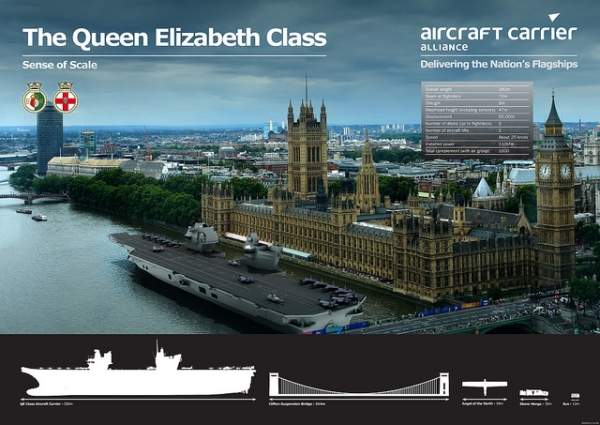

Hundreds of workers who helped build HMS Queen Elizabeth were joined by Britain’s Prime Minister, David Cameron, and a host of other dignitaries to watch the Queen christen her namesake on Friday.
Instead of the usual champagne christening, the Queen smashed a bottle of Islay whisky against the hull to honour the ship’s birthplace in Scotland. It’s the first time the Queen has christened a warship in 15 years.
The name HMS Queen Elizabeth carries a distinguished heritage for the Royal Navy, with the current aircraft carrier only the second ship to bear the name. The first Queen Elizabeth was the lead ship of the Queen Elizabeth class of dreadnought battleships which served in both world wars.
For the thousands of people who have helped build the current vessel, including 3,000 people in Rosyth alone, it is a time to celebrate. The carrier will be the Royal Navy’s flagship vessel and is expected to be in service for the next 50 years.
"This occasion marks a major milestone in regenerating the UK’s aircraft carrier capability, enhancing our ability to project power anywhere in the world," said Defence Secretary Philip Hammond.
As disputes rumble on about the UK defence budget and whether the Ministry of Defence was right to switch F-35 variants, BAE Systems has risen above it all.
Royal Navy’s biggest ever ship
So just how big is this ship? With a displacement of 65,000 tonnes she is the biggest aircraft carrier outside of the US and dwarfs the Invincible-class vessels she is replacing. In comparison, the famous HMS Ark Royal, which was decommissioned in 2011, only displaced 22,000 tonnes.
She is longer than the Houses of Parliament and if stood on end, is taller than the Spinnaker Tower in Portsmouth. The carrier’s on-board distribution network can manage enough energy to power a small town of 5,500 homes.
From keel to masthead she is 56m tall, which is four metres taller than Niagara Falls. The carrier has a flight deck area spanning nearly 13,000m2, which is the equivalent of 49 tennis courts. And if you really wanted to, the deck could accommodate over 470 London buses.
Of course, the deck won’t be full of London buses or Wimbledon fans, instead it will be chock-full of fifth-generation F-35 aircraft and other assets including Merlin helicopters. The hanger inside the carrier is 29,000m2, which can accommodate twenty fixed wing and rotary wing aircraft.
Two large lifts can take aircraft from the hangar up to the flight deck in just 60 seconds.

The 21st century Dam Busters
Although exact figures are still unknown, it is expected that during routine operations the ships will carry 12 F-35s, which could be ramped up in times of crisis. The British government has yet to place orders for the F-35B – a vertical short take-off and vertical landing aircraft – which is planned to enter service with the US Marine Corps next year.
Two historic squadrons from the Royal Navy and Royal Air Force will fly the F-35B from the Queen Elizabeth. One is 809 Naval Air Squadron, which was formed during World War II to protect Arctic Convoy missions and the other is 617 Squadron, more commonly known as the Dam Busters.
The Royal Navy says the new carrier will give Britain significant strategic reach and, in the words of First Sea Lord Sir George Zambellas, a return to carrier strike capability "last operated by the Royal Navy…four decades ago". With this capability, it is hoped Britain can project military power without committing ‘boots on the ground’.
"Powerful, versatile and credible, this ship will be at the heart of the UK’s defence capability for the next 50 years, but she already stands testament to the best of British shipbuilding, engineering and technology", said Zambellas at the naming ceremony.
Construction of the ship began five years ago in six UK shipyards. Shipbuilders in Glasgow, Devon, Tyneside, Birkenhead, Portsmouth and Rosyth built individual blocks which were eventually pieced together in Scotland.
The massive blocks, one weighing a massive 11,000 tonnes, were transported to Rosyth on ocean-going barges for assembly. According to the Ministry of Defence, the construction of HMS Queen Elizabeth has sustained around 8,000 jobs at more than 100 companies across the UK.
Cost increases and delays – ‘money down the drain’
All this hasn’t come cheap. In November 2013, the cost of constructing the Royal Navy’s flagship project – along with a second carrier named the Prince of Wales – had increased to GBP6.2 billion. That is close to double the initial estimates when Labour gave the go-ahead for the project in 2007.
In May 2012, the Ministry of Defence U-turned on a decision made in the 2010 Strategic Defence and Security Review (SDSR) to fit the aircraft carriers with catapult and arrestor cables (so-called cats and traps). That decision alone is thought to have cost GBP74 million, with one influential committee of MPs saying taxpayers’ money had gone "down the drain".
Many experts in the defence industry believe the decision to buy the F-35B was the wrong one, especially as it is a less capable platform than the F-35C in terms of range and weapons payload.
"A carrier of that size should have had catapults and arrestor wires," Rear Admiral Christopher Parry, former Director General, Development, Concepts and Doctrine at the MOD, told Strategic Defence Intelligence.
"It gives you a much greater mission capability, it also means you can operate other country’s aircraft off it," Parry added.
There are still unanswered questions in the programme, including whether the Royal Navy will operate the second aircraft carrier, Prince of Wales, and if the early warning radar system Crowsnest will be ready in time for the ship’s entry into service in 2020.
Today will be a day to celebrate for all those involved in the carrier programme but the hard work is not over just yet.
Follow Grant Turnbull on Google+


.gif)

